FEATURE
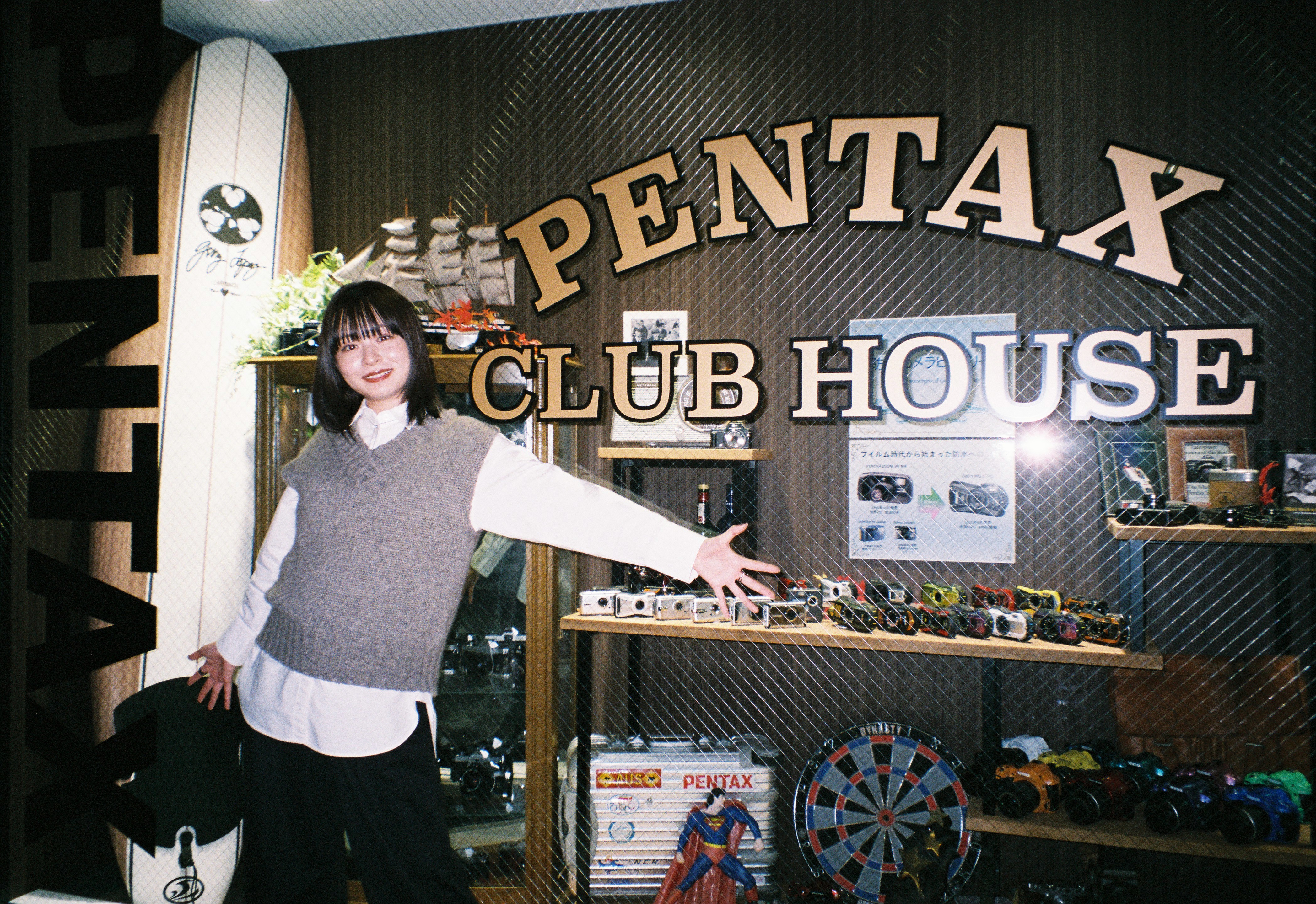
Short series PENTAX Film Project Club House Diary vol.7 Guest: Riko
DEC. 19 2023, 12:00PM
Photographs and text / Melanie Tada
Iikawa: We have been working on this project for about a year, and as a matter of fact, today we brought a prototype that is currently in the review stage. We would love to hear your honest feedback on it!
Riko: That’s a big responsibility (laughs). Wow, that’s amazing! Various operations are possible. What is this lever?
Iikawa: This is a “manual winding” lever that winds up each piece of film one by one by hand. All older cameras had this mechanism, but we decided to use it because we wanted to mix the old and the new as a camera made in the current era. We thought it would be enjoyable for people to feel like they are using a tool.
Riko: Come to think of it, I have only used a manual winding camera once and I remember it was a pleasant feeling. (Operates and makes a “click-click” sound.) That’s great!
Suzuki: That’s the sound of the many gears in the camera interlocking with each other. When building a new camera, we had to bring up old blueprints and assemble it from scratch, but it was difficult in many ways, as parts would get stuck and not work. With the advice of former employees, and sometimes a lot of angry words (laughs), we have finally made it this far.
Riko: I have several compact film cameras, but I can’t really operate them fully yet myself, so I still rely on the auto function. I really want to try using a manual winding camera, but since they’re often used, they don’t come with an instruction manual, and there’s a limit to how much I can find out about them online. When the new camera is completed, it would be great to have an easy-to-understand instruction manual and videos for beginners. By the way, I’ve been holding this prototype that’s currently in the review stage as we speak, and it’s very light. On top of that, it’s thin, so it would be even more convenient if it could be hung from the shoulder like a smartphone! It would be fun to have several types of straps to choose from, depending on your mood or outfit of the day. When I go someplace with beautiful scenery, I definitely want to take pictures not only with a digital camera or a smartphone, but also with a film camera, but recently small bags have been popular, you know? I’m a camera-first person (laughs), so when thinking about choosing a bag large enough to hold my camera, the ease of carrying it around is very appealing.
Suzuki: Thank you for your kind words. We wanted people to carry it around like a smartphone.
Riko: I always bring a film camera to every filming location, and I think this camera is cute and looks easy to carry, so I thought it would be appreciated by everyone on the set. Recently, I have the impression that more and more people around me, including my actor and model friends, are using film cameras. The “Utsurun Desu” disposable cameras were given to the performers on set, and we had many opportunities to take pictures of each other and post them on the program’s official SNS account. For photos that I take with my personal camera, I go to a photo studio in town and have them transfer the images to my phone.
BARFOUT!: Are you particular about the brand of film you use?
Riko: I like the vivid colors of “Kodak,” because they feel modernistic, but they are in short supply at certain times of the year, so I generally just use whatever I can get my hands on. What’s fun about a film camera is that you can take dozens of shots, send them off to be developed, and finally have the photos delivered to you an hour later. There’s a sense of excitement in thinking about “how the photos I shot will turn out,” and it’s also fun to be able to look back and think, “This film takes 36 photos, and now I have 28 left, so I probably started taking these photos at around this time?” I can feel the passage of time with just one roll of film. I don’t really have much knowledge of cameras, but I simply enjoy taking photos and developing them, and I usually take photos while thinking, “I can’t wait to get these developed” (laughs). I want to increase the number of times I develop photos, so I usually buy film with 24 shots rather than 36 shots, and I go to get my photos developed about twice a month.
Suzuki: Wow, it seems like you’re really making full use of your camera. Since you’re here with us today, I wanted to ask you to take some photos for us, so I brought this delicious taiyaki (fish-shaped pastry) as a model for the shoot (laughs), and a “Ricoh Auto Half” film camera.
Iikawa: Normally, when you shoot, you get a full-size, horizontal image, but with this camera, you shoot at half the size of 35mm film, so you can arrange two pictures in one frame. Don’t you often see 2-in-1 photos on SNS?
Riko: Yes, I do see them a lot recently. It is interesting to see two different pictures side by side. I had no idea there were so many different types of film cameras.
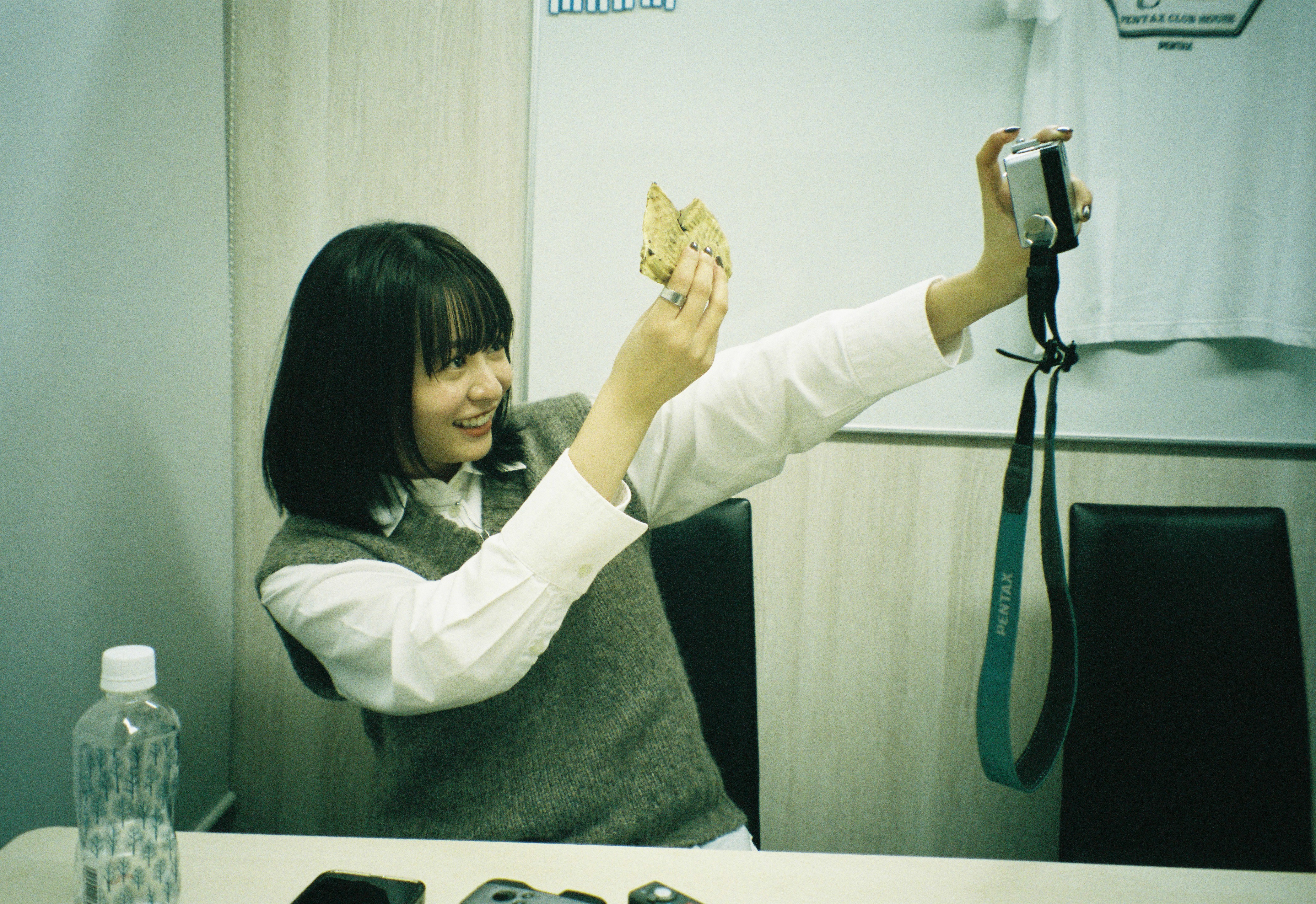
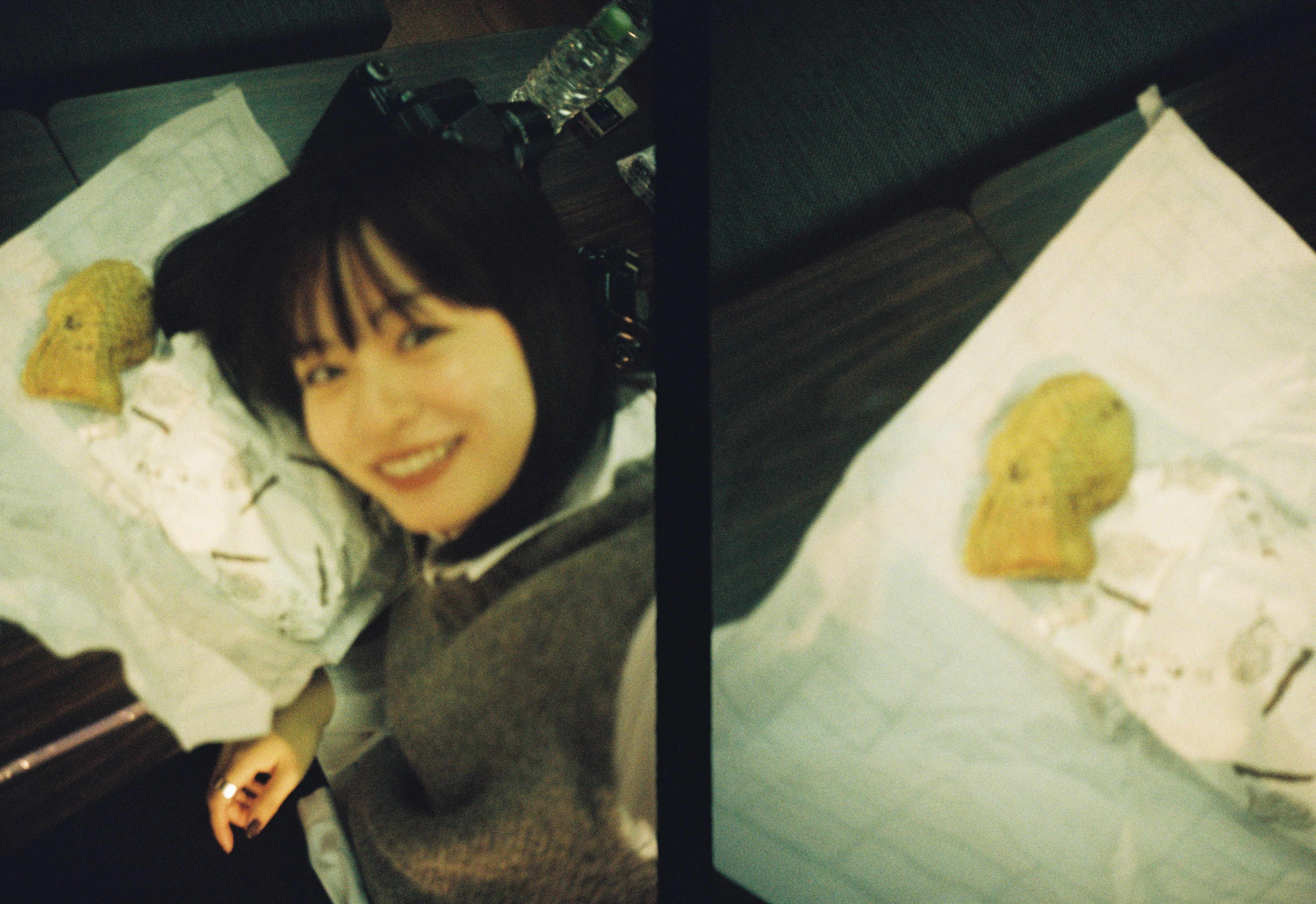
BARFOUT!: You started using film cameras with the “Utsurun Desu” disposable camera, What made you decide to use one in the first place?
Riko: When I was in high school, an app came out that let us take pictures in the style of a film camera, and I thought that while the app was nice, it would be more fun to actually take the pictures and develop the film. My mother was of the “Utsurun Desu” generation, and as she taught me how to use it, I became hooked on it. Some of the photos are blurry or fuzzy, but that’s part of the flavor and fun of it. Since we were not allowed to bring smartphones to my high school, I brought my “Utsurun Desu” and took pictures not only in everyday life, but also at my school’s sporting events and athletic festivals. (Shows photo) Like this one, isn’t it funny to see someone’s finger in the picture (laughs)?
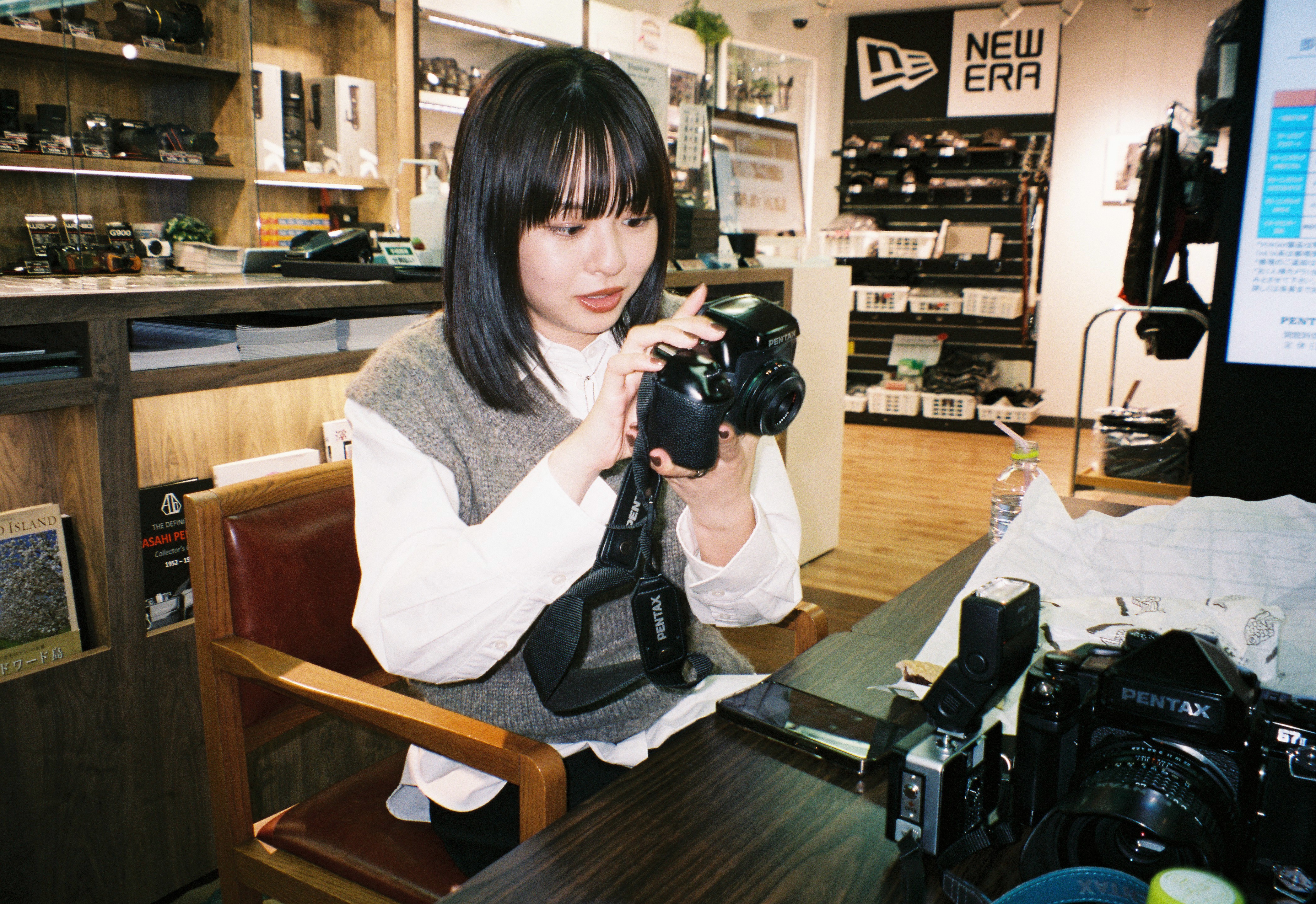
Iikawa: Yes, yes, this is the unique taste that a film camera offers! If you show it to someone who is familiar with cameras, they may say, “You messed up that photo,” but it is very difficult to convey what is good about film cameras, isn’t it? That is why I am very happy that young users like yourself are enjoying using film cameras and helping to popularize them.
Riko: Thank you. At first, I too was clueless and had no idea where to start. I just went online and looked up different models that were easy for beginners to use, found a website that sold used cameras, and finally reached the purchase screen. I thought to myself, “Is this really the right price for this model” (laughs). That being said, some of my friends who are trying to get started with film cameras ask, “Do you have any new film cameras?” and maybe because they are a little bit more difficult to find, not many people understand that there are only used ones available. And with used cameras, there are times when they inevitably break and become unusable, right? I think there is a part of us that is hesitant to invest in it because it is an expensive purchase.
Suzuki: Yes, that’s right. I often hear stories of users who have purchased a camera but received it in a broken condition, and when they go to the store, “We can’t repair this, it’s junk,” which really makes me feel sad. If we could release a new camera that comes with a full warranty from the manufacturer, that would eliminate that problem. If this prototype that is currently in the review stage goes well, we are hoping to get it on the market as soon as possible.

PHOTOGRAPHS BY TAKEO SUZUKI & RIKO
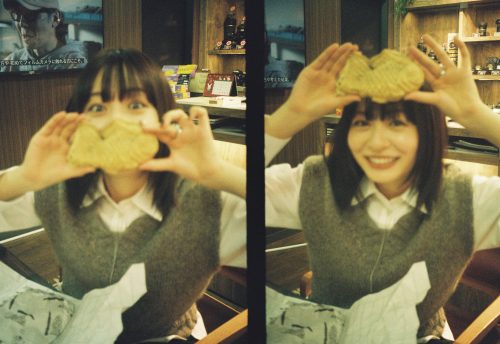
(1)
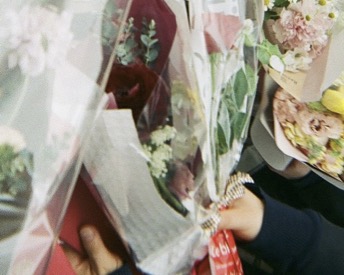
(2)
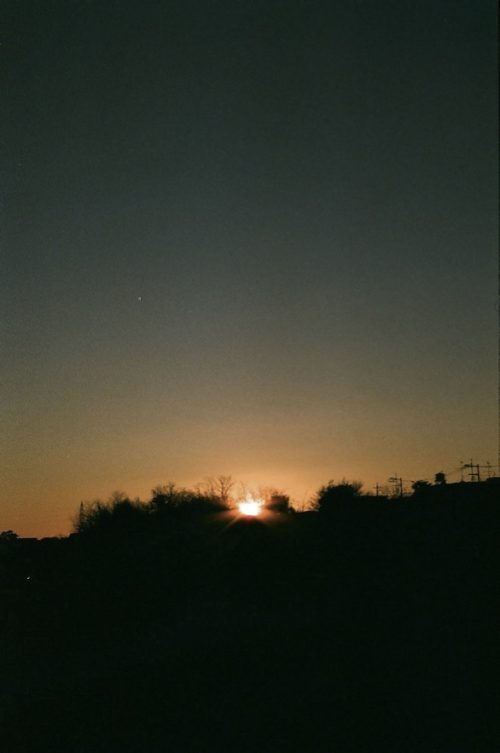
(3)
(1) Shot with the “Ricoh Auto Half”. Riko was full of curiosity as she looked at the examples of photos, saying, “I can combine them in so many ways.”
(2) “This was from my high school graduation ceremony. The bouquet that I received as a gift and all my precious friends who supported me and helped me for three years. The bouquet of flowers filling the screen and the irregularity of the image give it a film feel, making it one of my favorites and one of my most memorable photos.”
(3)” A few years ago, I was followed by a film crew for the first time in my life over the year-end and New Year’s holidays and went to see my first sunrise at that time. This was the beginning of a new year and my first drama series that I appeared in as the lead role, so I remember shooting amidst a wide range of emotions. This is one of my favorite photos that I was able to capture on film beautifully.”
INFORMATION ON PENTAX
The following website featuring a video introducing the “PENTAX Film Camera Project,” and articles from BARFOUT! is now open to the public.
www.ricoh-imaging.co.jp/english/pentax/filmproject
【WEB SITE】
ricoh-imaging.co.jp
【Instagram】
@pentax.jp
【X】
@ricohimaging_jp
INFORMATION OF RIKO
Currently appearing in the drama “SHUT UP” (TV Tokyo) and others. Her latest film, “Take Me to Another Planet,” in which she plays the lead role, opens in theaters nationwide on January 26, 2024.
【WEB SITE】
ndpromotion.co.jp/model/test-model-4
【Instagram】
@riko_riko1204
【X】
@riko_riko1204
【Tik Tok】
@riko_riko1204




